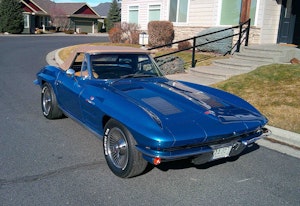Media | Articles
Behind the wheel of a $15 million 1935 Mercedes-Benz 540K
From behind the narrow, quad-spoked steering wheel, the 1935 Mercedes-Benz 540K Special Roadster appears to be all hood. This perception makes sense. The 17-foot-long coffee-brown convertible has a selfish little cabin, barely big enough for two people, set far back in the bodywork, just in front of a tidy tapered trunk. The rest of the car’s elegant bodywork—bracketed by flowing fenders on each side and an imposing, horizontally-beveled v-shaped chrome grille up front—is given over to the engine compartment.
This was a necessity in order for Mercedes to attempt to maintain its position as the manufacturer of some of the greatest and fastest cars in the world. The 540K was a linchpin in this plan. Created by designer Hermann Ahrens, who ran the marque’s special vehicle production unit at its plant in Sindelfingen near corporate headquarters in Stuttgart, and engineer Gustav Rohr, who ran Benz’s Grand Prix racing program, it was an update on the 380 and 500 roadsters that preceded it. Its core adaptation from its immediate forebear was in the engine compartment, where its tremendous, Roots-type supercharged straight-eight motor was bored out from 5.0 to 5.4 liters, giving it a maximum power of 180 horsepower, enough to roll this nearly three-ton behemoth to a top speed of 110 mph.
20180825000610)
“This car was, in the early ’30s, one of the most modern cars,” says Michael Plag, workshop specialist at the Mercedes-Benz Classic Center in Stuttgart, which owns the $15 million dollar vehicle, one of just over two-dozen made over a five-year run. “It was sold to New York back in 1935, then we bought it back in the early ’80s from the Harrah collection. This is its original condition. It’s been repainted in its original color, softly restored, but the body has never been off, the dash is all-original. The wood frame under the steel body is fully original ash and beech, with all of the factory stampings from Sindelfingen on it.”
The car’s power can be felt from the driver’s seat, especially when one takes the opportunity to floor the accelerator pedal, initiating kick-down mode, which engages the howling supercharger, slamming one’s head back over the leather tonneau. More than this, one can feel the sophistication of the engineering behind this car’s development. The four-speed manual transmission with overdrive is synchromeshed in the top three gears—one of the world’s first applications of this technology in a road car—providing more seamless shifting than in contemporary competitors. Likewise with the four-wheel independent suspension—a double-wishbone and coil springs setup at the front, with a double-joint swing axle with double coil springs a transverse balancing spring in the back—providing a strong handling upgrade over other marques, even if the front wheels still feel like they’re in the next time zone from any steering wheel inputs. And even the brakes are advanced, with a power vacuum assist at all four corners, although braking this giant eight-figure beast still requires the kind of planning more typically associated with Quincineras or retirement savings.
Marketplace
Buy and sell classics with confidence
Given its scale and value, you tend to provide a wide berth when you’re driving the 540K. Even on the grounds of the Pebble Beach Concours during Monterey Car Week, even people in other seven- or eight-figure classic cars. This is helpful to a panicked driver whose classic car insurance, despite being the best in the world, might not cover $15 million. Regardless, the car simply has presence, showcasing everything a Mercedes-Benz is meant to be: elegant, overly engineered, understatedly ostentatious, and just a bit haughty.
20180825000706)
Mercedes had plans to develop an even more advanced version of this automotive series, a 580K, with a more potent and larger 5.8-liter engine. But Nazi Germany’s initiating of a war of global domination in 1939, and the willing involvement of Mercedes in promoting this dastardly effort, meant that the Sindelfingen plant was converted to produce military vehicles and aircraft engines. (Conscripted slave labor—including those from concentration camps—was employed in the plant during the war.) The final two 540K roadsters were built in 1939. After this, a dozen armor-plated, six-passenger convertibles of the vehicle were built on a stretched wheelbase version of the chassis. All of these were built for top members of the Nazi hierarchy.
Properly humbled, Mercedes did not build another performance vehicle until well after the war. “I think the 300SL, the Gullwing, was the successor to this car, in the early ’50s,” Plag says. “Two seater. Big motor. Sports car. That’s the recipe for SL.”
20180825000643)








20180825000733)
20180825000719)
20180824203204)
20180824203351)
20180824203440)
20180824203338)

